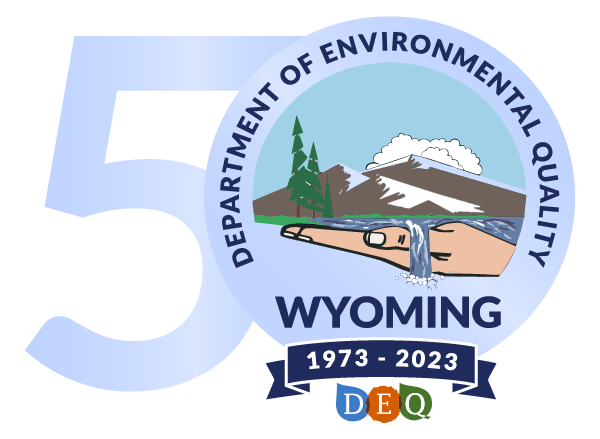An interagency group composed of the Wyoming Department of Environmental Quality – Water Quality Division (WDEQ-WQD), the Wyoming Game and Fish Department (WGFD), the Willwood Irrigation District, the United States Bureau of Reclamation, the Wyoming Water Development Office, the State Engineer’s Office, and others have been working on developing a plan to allow for the operation of Willwood Dam while also protecting the downstream Shoshone River fishery.
This group is advising the public that they may notice slightly higher turbidity in the Shoshone River downstream of Willwood Dam between October 16th and October 31st as the water level behind the dam is lowered in preparation for winter. Lowering the water level is necessary to prevent the dam and other infrastructure from freezing, but will be done in a manner that will minimize impacts to the downstream fishery.
This is part of a larger effort that has taken place since October/November 2016, when a large amount of sediment was released from behind Willwood Dam while maintenance work was being completed. In response to that event, WDEQ-WQD, WGFD, Willwood Irrigation District, and other partners formed three work groups tasked with 1) restoring aquatic life and habitat damaged by the sediment release; 2) evaluating alternatives for long-term management of the dam while also protecting downstream aquatic life; and 3) addressing sources of sediment upstream of Willwood Dam. Work thus far includes the following:
Trash Clean Up and Flushing Flow: On March 18th of this year, approximately 80 people from WGFD, WDEQ/WQD, Willwood Irrigation District, the Bureau of Reclamation, Cody-Powell Conservation Districts, Trout Unlimited, Cody High School Outdoor Club, Future Farmers of America, and the Greater Yellowstone Coalition joined forces to pick up trash and debris that was released with the sediment in the Willwood area.
Between April 3 and April 14 of this year, the Bureau of Reclamation assisted the effort through a request from the WGFD for a flushing flow of the Shoshone River by increasing the release of water from Buffalo Bill Dam from 2,000 cfs to 4,000 cfs. The purpose of the flushing flow was to remove fine sediment that had been deposited during the 2016 release and improve habitat for fish. In addition to the flushing flow, the Shoshone River also received natural flows of 6,000 cfs for several weeks, which was five times higher than typical summer flows. Evaluations of the habitat downstream indicate the flushing flow in combination with the high spring and summer flows removed nearly all of the sediment from the Shoshone River channel that was deposited in the 2016 release.
Evaluation of Fishery: The WGFD sampled the fish population downstream of Willwood Dam following the 2016 sediment release. A majority of the fish sampled in 2016 were brown trout less than 15 inches and rainbow and cutthroat trout less than 12 inches. The rainbow and cutthroat trout had been stocked prior to the sediment release. There were an estimated 442 trout per mile and 310 pounds of trout per mile in the Shoshone River following the 2016 release. This was down slightly from the estimated 478 trout per mile and 385 pounds of trout per mile estimated in 2013. Though it is difficult to quantify the direct loss of trout due to the release of sediment from Willwood Dam in 2016, the data suggest the sediment release led to a small reduction in the trout population and biomass. Game and Fish plans to continue monitoring the fishery to determine how the fishery is responding to management changes at Willwood Dam.
Measuring Sediment Load and Water Quality: To better understand the amount of sediment that passes through and potentially needs to be passed through Willwood Dam, WDEQ/WQD has contracted with the United States Geological Survey to conduct real-time monitoring of suspended sediment in the Shoshone River upstream and downstream of Willwood Dam. Turbidity, and eventually suspended sediment data, will be available at https://nrtwq.usgs.gov/ when the equipment is installed. WDEQ/WQD also continues to monitor water quality of the Shoshone River both upstream and downstream of Willwood Dam.
Addressing Upstream Sources of Sediment: Powell Clarks Fork Conservation District and WDEQ/WQD are leading an effort to identify potential sediment sources upstream of Willwood Dam and plan voluntary best management practices to address sources that can be mitigated. Representatives from state, federal, and local agencies are participating as well as local landowners and farmers. This group hosted a field tour in June 2017 to help educate agency personnel and other stakeholders on watershed characteristics and sources of sediment, including natural/background sources.
For more information, contact David Waterstreet, David.Waterstreet@wyo.gov or 307-777-6709, at the Wyoming Department of Environmental Quality or Jason Burckhardt, Jason.Burckhardt@wyo.gov or 307-527-7125 at the Wyoming Game and Fish Department.
###
